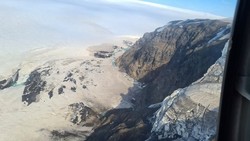Flood in Grímsvötn
Update 8.12. at 12:30The Icelandic Meteorological Office elevated the aviation color code from yellow to orange on the 6th of December for Grímsvötn volcano when the seismic actvity increased above normal level in the aftermath of the glacial outburst (which peaked on 05.12). On that day a M3,6 earthquake occurred at 6:16 UTC and 15 more earthquakes occured within the day. However, yesterday (07.12) very few earthquakes were identified in the area and the geophysical parameters all showed normal values. Based on these current observations, IMO moved the aviation color code from orange back to yellow as there were no clear indications for an imminent eruption.
„When the seismicity increased we needed to react as it could have been a typical precursor of a volcanic eruption“ says Kristín Jónsdóttir Team leader for operational natural hazard monitoring at IMO.
„We need to react to any relevant changes in the volcano activity. In this case it was likely that an eruption would have been triggered by the flood, and sometimes the time between the two events is not that long so we needed to be ready. This scenario, that a flood will trigger an eruption is becoming less likely as time passes“, says Kristín.
The Grímsvötn volcanic system is the most active system in Iceland and has erupted about 70 times during the last 1100 years. The precursors of an eruption can be very short and this is the reason why it is very important to monitor the area closely and to be ready to respond to any evident changes in the volcanic system.
Scientists will continue to monitor the area closely although there are currently no indications of an imminent eruption at Grísmvötn.
Update 3.12. at 15:07
The icesheet in Grímsvötn started to subside and the water started to drain out from the lake 10 days ago. IMO‘s GPS instruments show that the icesheet has now sunk over 27 meters. This morning, between 10:15 and 12:20, hydrologists from IMO measured a discharge rate of about 1600 m3/s in Gígjukvísl. The electrical conductivity, which is an indicator of the amount of geothermal meltwater in the river, has also been increasing over the last couple of days and it was over 464 µS/cm today. Higher than normal gas concentrations have been measured at the glacier edge, but they are currently within the health and safety levels.
The newest measurements are consistent with the flood forecast model, and it is highly likely that the flood will peak on Sunday.
There are past examples of Grímsvötn eruptions started following a flood. The loss of the water from Grímsvötn lake reduces the pressure on top of the volcano and this can allow an eruption to begin. This happened in 2004, and before that in 1934 and in 1922. In 2004 the eruption started three days after the first observations were made of flood onset. There were a series of earthquakes in the days preceding the eruption. No such earthquakes have been measured now.
The last eruption in Grímsvötn was in 2011. There was a flood 6 months prior to that eruption. Since 2011 there have been 6 floods without an eruption in the aftermath.
Recent eruptions in Grímsvötn have happened every 5-10 years and, considering measurements and observations, scientists agree that Grímsvötn is ready to erupt. It is still not possible, however, to anticipate if there will be an eruption following the current flood or not. IMO is monitoring the area very carefully to see if there are any indications of increased seismicity or gases that might indicate an imminent eruption.
IMO and scientists from the Institute of Earth Sciences continue to monitor Grímsvötn and will continue to provide updates as events evolve.
Updated 25.11 at 9:15
The icescheet has continued to
subside evenly throughout the night. IMO´s GPS instruments show that is has
sunk about 25 cm since 10:00 yesterday. There are no signs of increased water
level, electrical conductivity or gas in Gígjukvísl at this time.
Updated 24.11 at 16:30
The Scientific Advisory Board for the Civil Defense met today to discuss changes measured at Grímsvötn. GPS measurements are showing that the icesheet has started subsiding which indicates that a flood from Grímsvötn is likely starting.
The icesheet has now subsided about 60 cm in the last few days and the speed of subsidence has increased in the past 24 hours. These measurements indicate that it is most likely that water has started to leave from Grímsvötn lake and that Gígjukvísl will flood.
Based on observations of past floods, it is anticipated that flood water will be exiting the glacier edge in the next 48 hours and the flood will peak 4-8 days after that. At this moment no increase in electrical conductivity has been measured in Gígjukvísl which is the clearest sign that Grímsvötn flood waters have exited from under the glacier. IMO also has gas monitors along Gígjukvísl which will indicate if flood water has reached those points in the river.
The maximum discharge anticipated from this flood is calculated to be around 5000 m3/s. This size of flood will most likley not affect the infastructure in the area such as roads or bridges. These forecasts are uncertain at this early stage.
There are past examples of Grímsvötn eruptions starting following a flood. The loss of the water from Grímsvötn lake reduces the pressure on top of the volcano and this can allow an eruption to begin. This happened in 2004, and before that in 1934 and in 1922. In 2004 the eruption started three days after the first observations were made of flood onset. There were a series of earthquakes in the days preceeding the eruption. No such earthquakes have been measured at this point in time.
IMO continues to monitor Grímsvötn closely and will keep updating this news as things develop.




